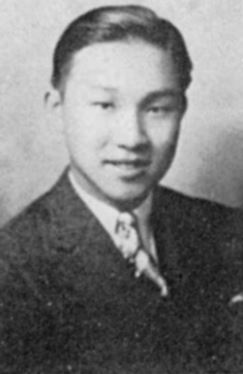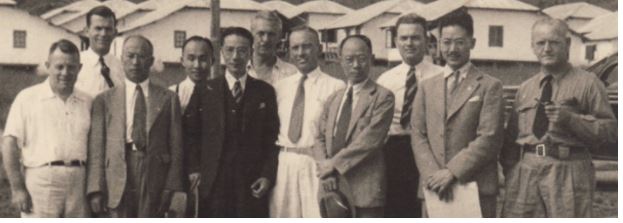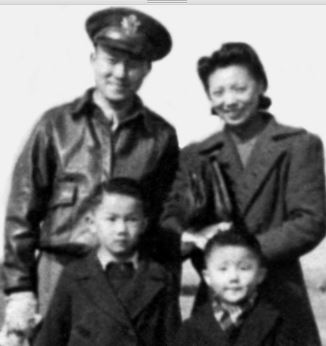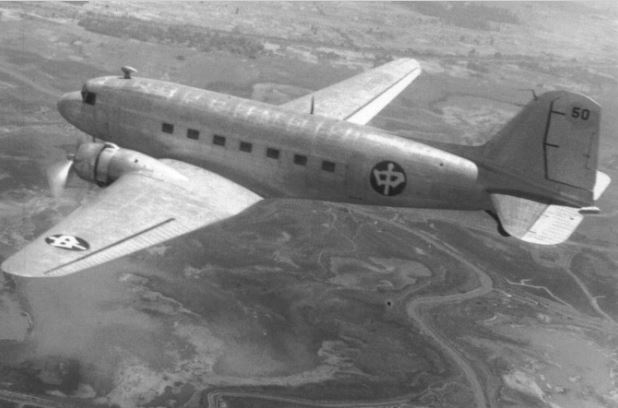China National Aviation Corporation Douglas DC-3
By Raymond Douglas Chong,AsAmNews Staff Writer
Between World War I and World II, Americans were wildly enchanted by The Golden Age of Flight. Newspapers, radio stations, and movie theaters covered the daring air races and record setting flights across America.
Moon Chen dreamed about a spirited career as an aviator. He would not only achieve his dream, but also become a member of the famed Flying Tigers and will soon be awarded a Congressional Gold Medal posthumously.
Orphaned at the age of 15, he worked his way through high school and helped to support his younger brother and sister. He persevered to graduate from McKinley High School in Canton, Ohio in 1928.
Pioneer Aviator in America

of Moon Chen in 1928.
Moon idolized Charles Lindbergh, the aviator who made a sensational nonstop solo flight in 1927 from New York City to Paris. He attended the University of Michigan at Ann Arbor. He had joined the F.F. Fraternity, established in 1910 for Chinese students attending colleges and universities in the United States. During weekends, he worked at a Chinese restaurant in Detroit. Moon graduated with a bachelor’s degree in aeronautical engineering from Michigan in 1932.
America was in midst of the Great Depression. Aeronautical engineering jobs were scarce. Moon also faced racial discrimination as aircraft companies refused to hire Orientals. Undeterred, he was deeply passionate about aviation and pursued it because it was different and distinctive.
Moon saved enough money to take flying lessons with propeller driven airplanes. He graduated in 1935 from a flying school on Long Island and earned a commercial pilot license.
He was a contract pilot on scheduled airmail service for the United States Post Office Department. He flew cross-country in an open cockpit biplane. During the dark days of the Great Depression, he gained confidence by flying.
“The sky is the limit; sky is my companion,” he once said. “To be sitting on top of the world and way above the clouds
An Aviator Flying the Blue Skies of China
The Imperial Japanese Army attacked the Chinese National Revolutionary Army at the Marco Polo Bridge southwest of Peking on July 7, 1937. Moon was flying over Marco Polo Bridge when he observed the clash. He immediately reported the incident to Nanking authorities. The incident marked the beginning of the Second Sino-Japanese War (1937 to 1945).
US Army Major General William Chen, Moon’s second son, recalled his tale:
“The Japanese Imperial Army launched a fierce attack at the Marco Polo Bridge,” said his son William. “Moon was flying over the bridge when the Japanese troops attacked. He immediately used his airliner’s radio to report the fighting to Nanking. He landed in Peking, but the next day Peking was on the verge of complete occupation by Japanese forces. Moon met his friend, the postmaster general, who gave him use of a mail truck which had a special pass. Moon hid under the mail sacks in the mail truck. At a roadblock, Japanese soldiers thrusted their bayonets through the mail sacks, but fortunately Moon escaped the thrusts. As soon as the mail truck got to the airport, he jumped out of the mail truck and ran to the airliner’s cockpit. Moon started to take off and saw a group of soldiers rushing toward the airliner and firing at him. He was quick in maneuvering the plane down the runway, and he was up in the air in no time. CNAC was grateful for Moon’s skill in saving the airliner.”

In 1939, Moon joined the Central Aviation Manufacturing Company, headed by President William Pawley, the Curtiss Wright Corporation representative in China. CAMCO received the contract to hire American personnel for the 1st American Volunteer Group, better known later as the legendary Flying Tigers, commanded by Claire Chennault, a retired US Army Captain. CAMCO was the company of record for AVG members. CAMCO provided the AVG with housekeeping services and assembly of 100 P-40 Warhawk single-engine, single-seat, all-metal fighter and ground-attack aircraft at Rangoon, Burma. Moon was involved with recruiting personnel and clandestinely moving them and equipment to the secret Loiwing factory at Yunnan near the China-Burma border. The factory was used to repair P-40s. AVG used its airfield to mount air raids into Thailand and Burma.
After the attack on Pearl Harbor, Moon joined the United States Army Air Forces as a First Lieutenant. He was assigned to the China Air Task Force, commanded by Brigadier General Claire Chennault, a combat organization. CATF was created in July 1942 after the Flying Tigers of the 1st American Volunteer Group was disbanded. In March 1943, the CATF was disbanded and replaced by the Fourteenth Air Force, in the China Burma India Theater.

Moon piloted C-46 and C-47 transport aircrafts. He flew VIPs (Chinese and Americans) and military supplies. He surveyed into unknown areas for the establishment of new airfields at CBI Theater. He flew The Hump route and made more than 500 missions over the Hump. The Hump was the eastern end of the Himalayan Mountains over which they flew military transport aircraft from India to China to resupply the Chinese war effort of Chiang Kai-shek, President of Republic of China, and the units of the AAF based in China. Flying over the Himalayas was extremely dangerous. Flying was made more difficult by a lack of reliable navigation charts, an absence of radio navigation aids, and a dearth of information about the weather. Later, Moon served General Chennault’s liaison officer to the Chinese Nationalist Air Force in Chungking. Captain Moon Chen was honorably discharged from the U.S. Army Air Forces in 1946.
In 1946, Claire Chennault and Whiting Willauer founded an airline in China, Civil Air Transport, to carry rehabilitation and recovery supplies across China. Many of its first pilots were veterans of Chennault’s World War II combat groups, popularly known as Flying Tigers. Using surplus World War II transport aircrafts, CAT airlifted supplies and food into war-ravaged China. It was soon pressed into service to support Chiang Kai-shek and his Kuomintang forces in the Civil War between Nationalists and the Communists under Mao Tse-tung, Chairman of the Communist Party.
In 1947, Moon joined the fledging airline as the area manager in Shanghai and later was the area manager in Canton. In Hong Kong, Moon was assistant to Chennault. In 1949, over 70 aircrafts belonging to CNAC and Central Air Transport Corporation were at the Kai Tak Airport in Hong Kong. Chennault was concerned that these aircrafts would be flown out of Hong Kong and be used by Communist China. Chennault was able to rapidly obtain financing to purchase the aircraft assets. This move successfully blocked these aircraft assets from falling into the hands of the Communists. With the assistance of the U.S. Government, CAT acquired these aircraft and precluded these aircraft from going to Communist China. CAT became U.S. owned and was reorganized as CAT, Inc., owned by the Central Intelligence Agency.
In 1950, Moon was assigned as Area Manager in Japan-Korea, where the CAT supported the U.S. Air Force in airlift operations during the Korean War. Moon was responsible for the development of cargo, passenger, and mail business on scheduled flights and for charter flight business. In January 1952, Moon became CAT’s first Director of Traffic & Sales. He helped establish passenger routes to Hong Kong, Tokyo, Manila, Seoul, and Bangkok. He was promoted to Vice President of Sales & Marketing and contributed to establishing CAT as a reliable and reputable regional airline in the Far East. From 1947 to 1959, Moon was based at Shanghai, Canton, Hong Kong, Tokyo, Taipei. In 1959, he quit CAT after death of President Claire Chennault.
After leaving CAT, Moon remained in Taipei and formed his own company in the import-export business. But he learned that his forte was still in the field of aviation. In the early 1970s, he Joined two American Flying Tiger aces as consultants to Northrop Aircraft Corporation to assist Northrop to win the coproduction program to produce 100 F-5E Tiger II, the second-generation supersonic light fighter aircraft for Republic of China Air Force. After 1973, he subsequently served as the program director, based at Taipei. In 1980, he finally retired.

Retirement in America
With Priscilla, his wife, Moon first retired at San Francisco, California. He later moved to Alexandria, Virginia, and then finally Chevy Chase, Maryland. He enjoyed his times with family.
Moon was an active community leader. He was a strong advocate for Chinese Americans to assimilate into the American society. With a loud booming voice, he was always the center of attention at cocktail parties and receptions and. In 1952, he was the youngest and first of Chinese origin to be designated as a 33rd degree Mason.
A strong supporter of his alma mater, Moon received the University of Michigan Distinguished Alumni Service Award in 1958 for advancing the presence of the University in the Asia-Pacific region. In 2014 he was designated, posthumous, a Distinguished Alumnus in Aerospace Engineering at the University of Michigan.
At age 101, Moon died peacefully on December 7, 2009, at Chevy Chase. His last gesture embodied his life as an aviator: he gave a “thumbs-up”- signifying “All is well,” in aviator’s language, while also means “ding how” or the “very best” in Chinese.
US Army Major General William Chen mused about Moon, his father:
“Moon Chen was my father. Living in the shadow of your father is something every son or daughter faces. Like many others, we are influenced by the time period we live in, our environment, and the prevailing socio-economic situation. That is part of growing up and acquiring our sense of values and work ethics. So, yes, I was influenced by Moon’s life, what he did, and his values.”
Moon Chen had an illustrious career as a Chinese American aviator with a career of 45 years (1935 to 1980) in aviation. His story arc began by being not hirable during the Great Depression as an aeronautical engineer by an aircraft company in spite of being American-born. He then got his commercial pilot’s license and served as an airliner pilot for China National Aviation Corporation, company pilot for Central Aviation Manufacturing Company, Hump pilot for U.S. Army Air Forces – Flying Tigers, and airline executive for Civil Air Transport. With that experience, background, and his skills, competencies, and knowledge of the customer base, he then became in demand and his story arc was completed when he was hired by an aerospace company – Northrop Aircraft Corporation to manage and introduce jet aircraft manufacturing in Asia. His story continues the legacy of progress of Chinese Americans, where his father was the first of his family in America and who helped to build the second Transcontinental Railroad in the United States.
Chinese American World War II Veterans Congressional Gold Medal Act
United States Army Air Forces Captain Moon Chen will be among those Chinese American World War II veterans who will be awarded with the Congressional Gold Medal sometime after the pandemic.
(Correction: An earlier version of this story incorrectly stated he as born in Ohio and grew up on the Pearl River Delta in Kwangtung. That was actually his father who grew up there. We regret the error).
AsAmNews has Asian America in its heart. We’re an all-volunteer effort of dedicated staff and interns. Check out our new Instagram account. Go to our Twitter feed and Facebook page for more content. Please consider interning, joining our staff, or submitting a story.


Raymond this was a well executed post that kept me totally entrenched in the story. Well done
Raymond Chong, nicely written feature piece. Well researched with details. A rare detailed document about a Chinese American’s contribution to U.S. aviation history and WWII. Wishing you continued success. I’ll be looking for other stories by you.
Jim Wong, San Francisco, CA.